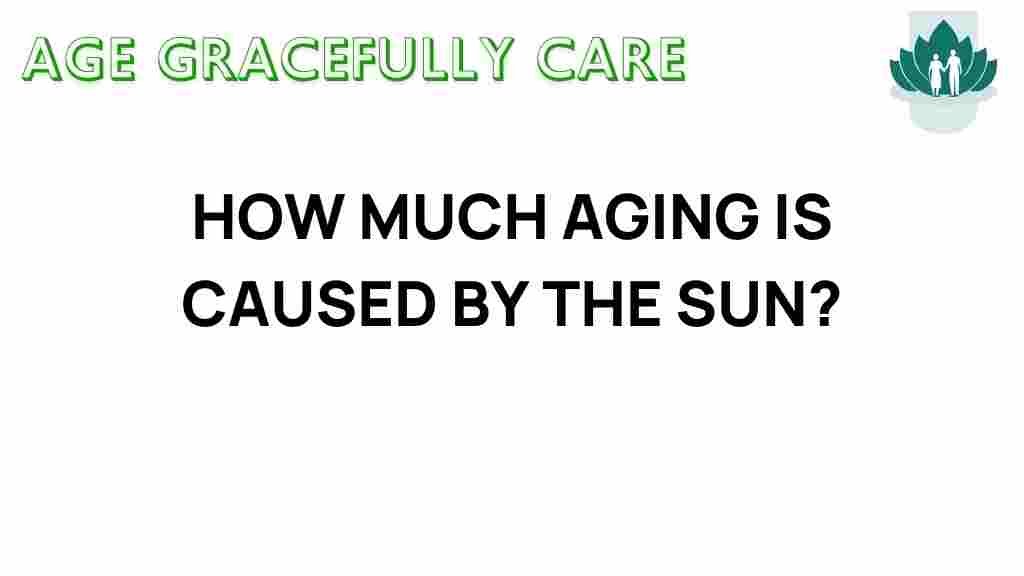Unmasking the Sun: How Much of Our Aging Is Its Fault?
The sun, a source of life and vitality, is also a significant contributor to the aging process. With increasing awareness of skin health and the effects of UV exposure, many people are left wondering how much of our aging can be attributed to the sun. In this article, we will explore the connection between sun damage and aging, the science behind UV exposure, and actionable skincare tips to protect your skin from premature aging.
Understanding Aging and Sun Damage
Aging is a natural process that is influenced by various factors, including genetics, lifestyle, and environmental exposures. One of the most significant environmental factors affecting our skin is sun exposure. The sun emits ultraviolet (UV) rays, which can lead to skin damage and accelerate the aging process.
The Science Behind UV Exposure
UV rays are divided into two main types: UVA and UVB. Understanding these rays is crucial for comprehending how they contribute to skin damage:
- UVA rays: These rays penetrate deep into the skin and are primarily responsible for premature aging, including wrinkles, fine lines, and age spots. They can also contribute to skin cancer.
- UVB rays: These rays cause sunburn and are important for the development of skin cancer. While they affect the outer layers of the skin, their impact is more immediate than that of UVA rays.
Both types of UV rays can lead to oxidative stress in the skin, which damages cells and accelerates the aging process. This oxidative stress is where antioxidants come into play.
The Role of Antioxidants in Skin Health
Antioxidants are compounds that help neutralize free radicals produced by UV exposure and other environmental stressors. By incorporating antioxidants into your skincare routine, you can help combat oxidative stress and maintain healthier skin. Some effective antioxidants include:
- Vitamin C: Brightens the skin and helps reduce the appearance of age spots.
- Vitamin E: Protects the skin from UV damage and aids in skin repair.
- Green tea extract: Contains polyphenols that help reduce inflammation and protect against UV damage.
- Coenzyme Q10: Supports skin cell energy and helps reduce the appearance of wrinkles.
Step-by-Step Process for Protecting Your Skin
To minimize sun damage and its effects on aging, it’s essential to adopt a comprehensive skincare routine that includes sun protection. Here’s a step-by-step guide:
Step 1: Daily Sunscreen Application
The most crucial step in protecting your skin from sun damage is applying sunscreen daily. Here’s how to do it effectively:
- Choose a broad-spectrum sunscreen that protects against both UVA and UVB rays.
- Opt for an SPF of at least 30 for daily use.
- Apply sunscreen generously to all exposed skin, including the face, neck, and ears.
- Reapply every two hours, or more often if swimming or sweating.
Step 2: Incorporate Antioxidants
Adding antioxidants to your skincare routine can help protect against sun damage:
- Use a vitamin C serum in the morning before applying sunscreen.
- Choose moisturizers with vitamin E or green tea extract.
- Consider a retinol product at night to promote skin renewal and combat signs of aging.
Step 3: Regular Skin Check-ups
Regular visits to a dermatologist can help monitor your skin health:
- Schedule annual skin exams to catch any potential issues early.
- Discuss any changes in your skin, such as new moles or changes in existing moles.
Step 4: Lifestyle Choices
In addition to your skincare routine, lifestyle choices play a significant role in skin health:
- Hydration: Drink plenty of water to keep your skin hydrated.
- Diet: Incorporate fruits and vegetables rich in antioxidants, such as berries and leafy greens.
- Avoid tanning beds: These can significantly increase your risk of skin damage and premature aging.
Troubleshooting Common Skin Issues
Even with diligent sun protection and skincare, you may encounter some common skin issues related to sun damage and aging. Here’s how to address them:
Issue 1: Sun Spots
Sun spots, or age spots, are flat brown or black spots that develop on sun-exposed areas of the skin. To treat sun spots:
- Use products with hydroquinone or glycolic acid to lighten spots.
- Consider professional treatments like chemical peels or laser therapy.
Issue 2: Wrinkles and Fine Lines
Wrinkles are a natural part of aging, but sun damage can accelerate their appearance. To reduce wrinkles:
- Incorporate retinol into your skincare routine for enhanced cell turnover.
- Use peptides in your moisturizer to promote collagen production.
Issue 3: Dry Skin
Sun exposure can lead to dry and flaky skin. To combat dryness:
- Moisturize regularly, especially after sun exposure.
- Consider using a humidifier in dry environments.
Conclusion: Embracing Healthy Skin Practices
Understanding the impact of sun damage on aging is crucial for maintaining skin health. By adopting a proactive approach that includes sun protection, antioxidant use, and regular skincare practices, you can significantly reduce the effects of UV exposure and preserve your skin’s youthful appearance.
Remember, while we cannot stop the aging process, we can influence how our skin ages. Protecting your skin from the sun is one of the most effective ways to prevent premature aging. For more detailed skincare advice, consider consulting with a dermatologist or exploring reputable skincare resources.
Ultimately, the key to healthy skin lies in understanding the factors that contribute to aging and taking steps to mitigate their effects. Start incorporating these practices today, and embrace a future with healthier, more radiant skin!
This article is in the category Health and created by AgeGracefullyCare Team
